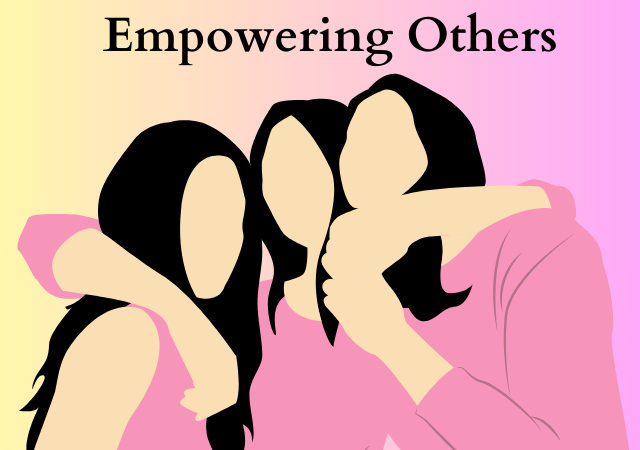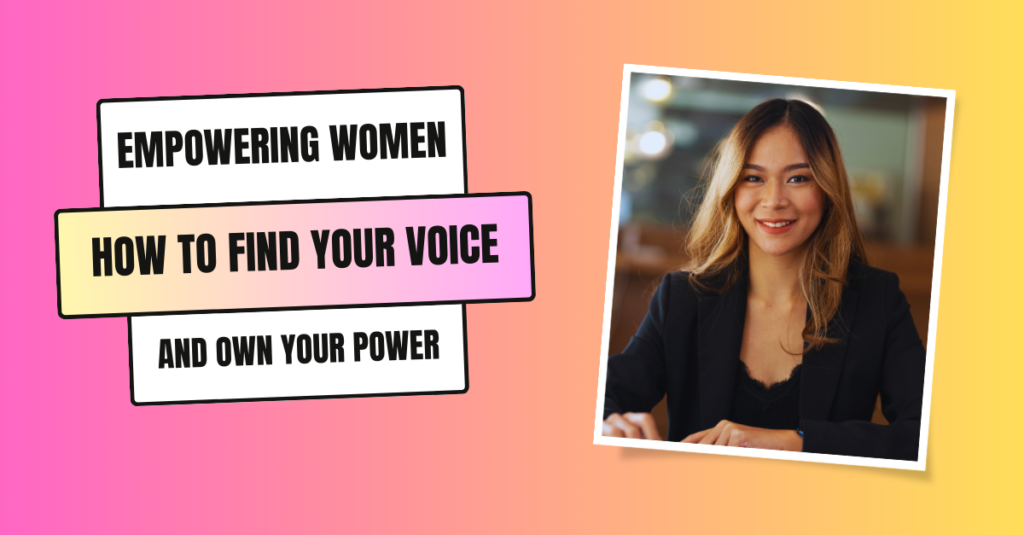Empowering Women: How to Find Your Voice and Own Your Power
Introduction
In a world where diversity and inclusivity are increasingly celebrated, the empowerment of women is not merely a catchphrase but a pivotal aspect of progress and social evolution. “Empowering Women: How to Find Your Voice and Own Your Power” serves as a roadmap for women seeking to traverse the path of self-discovery, assertiveness, and personal fulfillment. This guide is more than an exploration of gender roles; it is a manifesto encouraging women to embrace their uniqueness and unlock the latent power within.
Through the lenses of self-awareness, confidence-building, and effective communication, this article charts a transformative journey, illuminating the way for women to break free from societal constraints and claim their space with grace and resilience. Join us on this empowering odyssey, as we illuminate the way for women to break barriers, set and achieve goals, and ultimately empower others in a ripple effect of positive change.
Empowering Women: How to Find Your Voice and Own Your Power
I. Understanding Empowerment

Empowerment is a multifaceted concept that encompasses the recognition of one’s strengths, the dismantling of limiting beliefs, and the cultivation of an unwavering self-confidence. To embark on the journey of empowerment, women must first understand the core components that contribute to this transformative process.
A. Definition and Components of Empowerment
Empowerment involves the process of gaining the knowledge, skills, and mindset necessary to take control of one’s life. It comprises self-awareness, confidence, and the ability to make informed decisions. Understanding these components allows women to navigate the complexities of their lives with purpose and intention.
B. Historical Context of Women’s Empowerment
Examining the historical context of women’s empowerment unveils the progress made over time and the persistent challenges faced. From the suffragette movement to contemporary gender equality initiatives, women have consistently fought for their rights. Acknowledging this history provides a foundation for women to appreciate the strides made and the work that remains to be done.
C. The Link Between Empowerment and Personal Fulfillment
Empowerment is not merely a societal construct but a deeply personal journey that leads to self-fulfillment. By understanding the connection between personal growth and empowerment, women can recognize that their journey is not only about breaking barriers but also about creating a life that aligns with their values and aspirations.
II. Finding Your Voice

A. Importance of Self-Awareness
Self-awareness is the cornerstone of finding one’s voice. It involves recognizing and understanding one’s strengths, weaknesses, values, and passions. By cultivating self-awareness, women can develop a solid foundation from which their authentic voices can emerge.
- Recognizing Strengths and Weaknesses: Women must embark on a journey of self-discovery to identify and celebrate their strengths. Embracing weaknesses is equally vital, as it allows for growth and resilience. Understanding one’s unique qualities lays the groundwork for building a powerful and authentic voice.
- Embracing Individuality: Empowerment stems from embracing individuality and resisting societal pressures to conform. Each woman possesses a unique set of qualities and experiences that shape her perspective. By embracing and expressing these individual aspects, women can contribute authentically to conversations and societal changes.
B. Overcoming Self-Doubt
Self-doubt can be a significant obstacle on the path to empowerment. Challenging and overcoming limiting beliefs is crucial for women to unlock their true potential.
- Challenging Limiting Beliefs: Women often internalize societal expectations and stereotypes that undermine their confidence. Identifying and challenging these limiting beliefs is essential for dismantling self-doubt. Affirmations, positive self-talk, and reframing negative thoughts can be powerful tools in this process.
- Building Self-Confidence: Confidence is a key element of finding one’s voice. Building self-confidence involves acknowledging achievements, setting realistic goals, and stepping out of comfort zones. As women experience success and push boundaries, their confidence grows, empowering them to speak up and advocate for themselves.
C. Developing Effective Communication Skills
Effective communication is fundamental to finding and expressing one’s voice. It involves not only speaking assertively but also actively listening and engaging in meaningful conversations.
- Active Listening: Active listening is a skill that fosters understanding and empathy. By actively listening to others, women can cultivate stronger connections, gain valuable insights, and refine their own communication style.
- Assertiveness: Assertiveness is the ability to express thoughts, feelings, and needs confidently and respectfully. Developing assertiveness allows women to navigate professional and personal relationships with authenticity, ensuring that their voices are heard and respected.
III. Owning Your Power

Owning one’s power involves recognizing and leveraging personal strengths, setting and achieving goals, and establishing healthy boundaries. This section explores the practical steps women can take to assert their power confidently.
A. Recognizing Personal Strengths
Identifying and acknowledging personal strengths is a crucial aspect of owning one’s power. Women can undertake self-assessment exercises, seek feedback from mentors, and reflect on past achievements to uncover their unique strengths.
- Identifying Skills and Talents: Women often underestimate their skills and talents. Through self-reflection and feedback from peers, women can uncover hidden talents and leverage them to enhance their personal and professional lives.
- Leveraging Achievements: Reflecting on past achievements provides a confidence boost and a reminder of the capabilities one possesses. Women can use these accomplishments as a source of empowerment, demonstrating to themselves and others the value they bring to various aspects of their lives.
B. Setting and Achieving Goals
Setting and achieving goals is a powerful way for women to assert their agency and demonstrate their competence.
- SMART Goal-Setting: Setting Specific, Measurable, Achievable, Relevant, and Time-Bound (SMART) goals provides a clear roadmap for success. Whether in personal or professional domains, goal-setting allows women to focus their efforts and track their progress.
- Celebrating Small Victories: Acknowledging and celebrating small victories along the way is essential for maintaining motivation and momentum. By recognizing their progress, women can reinforce a positive mindset and cultivate resilience in the face of challenges.
C. Establishing Boundaries
Establishing and maintaining boundaries is vital for preserving personal well-being and asserting one’s power.
- Saying No with Confidence: Women often face societal expectations to be accommodating, leading to difficulties in setting boundaries. Learning to say no with confidence is an essential skill that allows women to prioritize their needs and protect their time and energy.
- Prioritizing Self-Care: Self-care is integral to maintaining a healthy balance between personal and professional responsibilities. Prioritizing self-care not only ensures well-being but also strengthens a woman’s ability to own her power and make meaningful contributions to society.
IV. Overcoming Challenges

Despite progress, women still encounter societal barriers, workplace challenges, and personal setbacks. Overcoming these challenges requires resilience, a supportive network, and a commitment to continuous learning.
A. Addressing Societal Barriers
Societal barriers, including gender stereotypes and biases, can hinder women’s progress. By challenging these norms and advocating for change, women can contribute to a more inclusive and equitable society.
- Gender Stereotypes: Breaking free from traditional gender stereotypes involves challenging societal expectations and embracing diverse expressions of femininity. Women can redefine success on their terms and inspire others to do the same.
- Workplace Challenges: Workplace challenges, such as gender discrimination and unequal opportunities, persist in many industries. Women can navigate these obstacles by seeking mentorship, advocating for themselves, and fostering a supportive work environment.
B. Building a Support Network
Building a support network is essential for navigating challenges and finding encouragement along the way.
- Mentors and Role Models: Establishing connections with mentors and role models provides guidance and inspiration. Women can learn from the experiences of those who have walked similar paths, gaining valuable insights and advice.
- Networking with Other Empowered Women: Connecting with other empowered women creates a community of support. Networking allows women to share experiences, exchange ideas, and collaborate on initiatives that promote empowerment and equality.
C. Resilience and Perseverance
Resilience is the ability to bounce back from setbacks and challenges. Cultivating a growth mindset and viewing setbacks as opportunities for learning enables women to persevere in the face of adversity.
- Learning from Setbacks: Rather than viewing setbacks as failures, women can approach them as opportunities for growth. Learning from challenges fosters resilience and equips women with the skills needed to overcome future obstacles.
- Cultivating a Growth Mindset: A growth mindset involves seeing challenges as opportunities to develop and improve. By embracing a mindset that values effort and continuous learning, women can navigate their journeys with optimism and resilience.
V. Empowering Others

The journey to empowerment is not solitary; it creates a ripple effect that extends beyond individual lives. Empowered women have the capacity to inspire and uplift others, fostering a culture of collaboration and support.
A. The Ripple Effect of Empowerment
Empowerment is contagious; as women find their voices and own their power, they inspire others to do the same. The ripple effect extends to families, communities, and societies, creating positive change on a broader scale.
- Inspiring and Supporting Others: Sharing personal stories of empowerment and supporting other women on their journeys create a culture of encouragement. By lifting others, women contribute to a collective empowerment that transcends individual achievements.
- Collaborative Empowerment: Collaboration among empowered women amplifies their impact. By joining forces, women can address systemic issues, advocate for policy changes, and create environments that foster equality and empowerment for all.
B. Mentorship and Leadership
Mentorship and leadership play pivotal roles in empowering future generations of women.
- Becoming a Mentor: Empowered women can become mentors, guiding others on their journeys. Mentorship provides a platform for sharing knowledge, offering guidance, and fostering the growth of emerging leaders.
- Fostering a Culture of Empowerment: In leadership roles, women have the opportunity to shape organizational cultures that prioritize diversity, equity, and inclusion. By advocating for policies that support work-life balance, equal opportunities, and mentorship programs, female leaders contribute to a more empowering workplace.
Conclusion (Empowering Women: How to Find Your Voice and Own Your Power)

My name is Rohit Vagh and I’m a content writer specializing in fashion and lifestyle. I have three years of experience in this field and have written various articles. My writing style is creative and engaging, and I strive to create content that resonates with my readers. I have a deep passion for fashion and am constantly researching the latest trends and styles to make sure my readers are up to date. I’m excited to continue my career in blogging, and I’m always looking for new opportunities in the fashion and lifestyle space.





